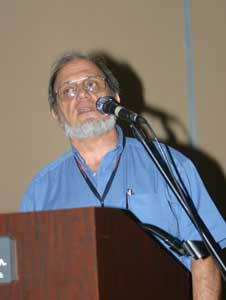Golden Alga (Prymnesium parvum) in Texas
Workshop Abstracts
Prymnesium parvum: An Overview and Questions.
 Carmelo
R. Tomas
Carmelo
R. Tomas
Center for Marine Science, University of North Carolina at Wilmington, 5600 Marvin K. Moss Lane, Wilmington, NC 28409 USA
Abstract.--The ichthyotoxic flagellate Prymnesium parvum has historically been a persistent problem in lakes, ponds, rivers and estuaries. In 1937, N. Carter described this species from a brackish pool on the Isle of Wight, England. Within the first decade of its description, this species was identified as causing extensive fish kills in Lake Kinneret (Sea of Galilee), Israel, and in aquaculture ponds. From 1947 through the 1960’s, Israeli scientists performed extensive studies to determine methods of controlling the blooms. The hemolytic nature of the toxin, a general understanding of how the toxin was formed, and the reaction to the fish were described, a standard bioassay was established, and mitigation efforts involving liquid ammonia were tested and offered as a means to control the blooms. This effort, notwithstanding, the blooms of P. parvum persisted and spread elsewhere, and now this species is identified from 14 different countries, spanning Scandinavia, Europe, Africa, Asia, New Zealand, and North and South America.
One of the first challenges in dealing with P. parvum is its identification. As a small (> 10 µm) highly motile cell, detection of its flagella and haptonema can be accomplished with brightfield microscopy, but the diagnostic body scales and other features require the use of electron microscopy (TEM and SEM). This is time consuming and requires specialized equipment not practical for routine observations. The blooms of this organism are episodic, appearing overnight and either persisting or disappearing rapidly. Maximum densities often exceed 108 cells/liter and once established, P. parvum becomes a persistent feature of the phytoplankton. This last feature suggests a survival stage that needs to be described and detected.
Conflicting evidence for conditions accompanying blooms are noted. They occur at low (<1 PSU) and high (>35 PSU) salinities. This species is photosynthetic but extremely tolerant to low light intensities and can survive in the dark with organic carbon sources. It requires a dark cycle for the production of toxin and has been reported to produce toxins at low (<10) as well as high (>30 µC) temperatures. Nutrients, discussed by others, give an equally confusing picture.
Great headway has been accomplished as to the toxins, but it is clear that they are complex, difficult to characterize and detect, and consist of multiple toxins having hemolytic, ichthyotoxic, neurotoxic, reactive oxygen, and other components. Linkages between environmental variables and toxin production are very complicated to discern.
Our present knowledge of P. parvum blooms requires
a series of efforts to be able to help in understanding their dynamics. Some
of the major problems to be confronted are:
• Easy, rapid and accurate identification of the P. parvum
in natural waters particularly at low cell concentrations.
• Detection and distributional mapping of P. parvum resting
stages (cysts) for identifying potential bloom initiation points.
• Accurate and easy detection of its toxins (kinds and levels) to diagnose
problems and to evaluate remediation efforts to relieve bloom effects.
• Development of a series of bioassays to guide efforts in defining
the fate and effects of the P. parvum toxins (bioassay guided fractionation
and mitigation to determine toxin ½ life and potential beneficial uses).
• Mitigation and control of the blooms in defined situations via particle
removal, cell lysis or other effective agents causing minimal damage to the
environment.
Download
presentation  (PDF 2.2 MB). If
you are unable to access this document, please contact
us for an alternative format.
(PDF 2.2 MB). If
you are unable to access this document, please contact
us for an alternative format.